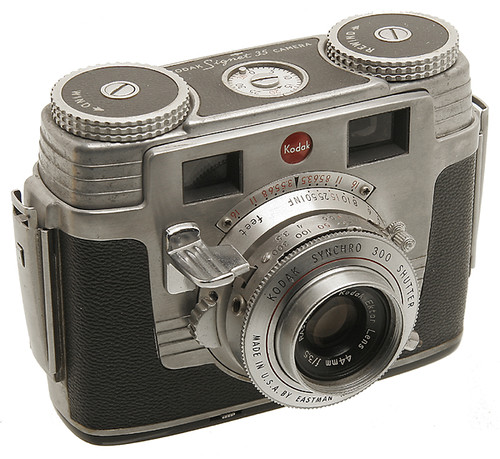Kodak Signet 35

|
| Kodak Signet 35 (1952) by Rick Soloway |
The Kodak Signet 35 was Kodak's top American-made 35mm camera of the 1950's and the first of the Kodak Signet camera line. The Signet 35 has a coupled coincident image rangefinder, an excellent Ektar 44mm f3.5 lens with rear helicoid focus, automatic film stop counter with double exposure prevention, all built into a sturdy cast aluminum alloy body. You have to manually cock the shutter. The shutter works fairly well, but compared with the shutters on equivalent German and Japanese cameras of the period, it's a real disappointment. The Signet 35 originally sold for $95 USD[1] (app. $810 USD in 2007). The design was by Arthur H Crapsey, and it was made between February 1951 - March 1958[2]. The signet 35 is a very interesting camera as it shows some details that make it special however not comparable to german and japanese counterparts: It´s extremely strong as the body itself is a cast machined aluminum single piece. Both advance and rewind are operated by big teethed wheels, able to be operated with gloves. The shutter release button is a big plate able too to be operated with gloves. The shutter itself is an extremely simple design having big levers to set both speed and aperture (also allowing to use gloves). The focusing assy. is made with a ball bearing making it easy and smooth, the focusing lever, again is able to be used with gloves because of its size. There are two other versions: one finished in black anodized aluminum made for the USAF, and another finished in olivegreen made for the Army. Being the price of this camera when released more expensive than other superior models of the same series leads to think that this camera was only a civilized version of a military designed camera.
La Kodak Signet 35 era una cámara fotográfica de 35mm, americana de gama superior de Kodak de los años 50. Es telémetrica, con objetivo excelente Ektar de 44mm/f3.5, con el foco helicoide posterior, contador automático de película, con un sistema de doble prevencion de la exposición, construida todo en un cuerpo robusto de aleación de aluminio moldeado. Se tiene que cargar manualmente el obturador. El obturador funciona bastante bien, pero comparado con los obturadores en las cámaras fotográficas alemanas y japonesas equivalentes del período, es verdaderamente inferior. Diseñado por Arthur H Crapsey, y se realizó entre febrero de 1951 y marzo de 1958.

|
| Kodak Signet 35 (1952) by Flickr user jgs4309976 |
Links
- PDF Manual on Mike Butkus's site
- Repair Notes
- Signet 35 at Sylvain Halgand's www.collection-appareils.fr
- History of Kodak Cameras